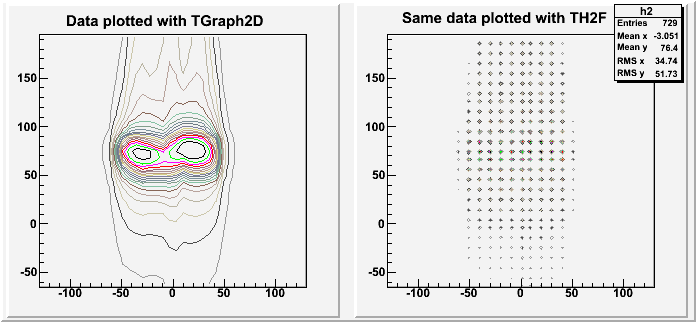Dear List,
I’ve got an MxN matrix dataset which I’ve converted into an ascii file with three columns, x, y and z, where z is the weighted values of f(x,y). Plotting the ascii file using the TGraph2D constructor is not an issue.
But the problem is that I’ve got a batch of similarly structured files that need analysing. TGraph2D seems to be limited in this regard, so ideally I would like to do this using the 2D histograms. However I can’t get an identical result when using 2D histograms. Is there something I am missing perhaps? 
Any help would be greatly appreciated! 
See below for macro script and output showing the same plot for TGraph2d vs. TH2F
Thanks.
#include "Riostream.h"
void Sample() {
// Reads data from an ascii file with Z as weighted values of function f(x,y)
// and plot as 2D histogram.
TString dir = gSystem->UnixPathName(gInterpreter->GetCurrentMacroName());
dir.ReplaceAll("Sample.C","");
dir.ReplaceAll("/./","/");
ifstream in;
in.open(Form("%sMeasured.dat",dir.Data()));
//
//::::::::: 3 coluns of data x, y, z, where z is weighted function f(x,y)
//
// First use TGraph2D constructor to see what plot looks like:
TCanvas *c1 = new TCanvas("c1"," ",0,0,700,350);
c1->Divide(2,1);
c1->cd(1);
TGraph2D *g1 = new TGraph2D("Measured.dat");
g1->Draw("cont1");
//
// Next repeat process by reading in ascii file into 2D histo and plotting
c1->cd(2);
Float_t x,y,z;
Int_t nlines = 0;
// TFile *f = new TFile("Sample.root","RECREATE");
TH2F *h2 = new TH2F("h2","Same Measured Data with 2DHisto",100,-130,130,100,-65,195);
while (1) {
in >> x >> y >> z;
if (!in.good()) break;
h2->Fill(x,y,z);
nlines++;
}
printf(" found %d points\n",nlines);
in.close();
h2->Draw("cont1");
// f->Write();
c1->Update();
}
For data used to generate plots see
Measured.dat (12.3 KB)

 !
!